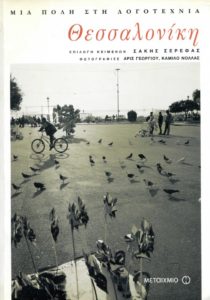The Kalamaria quarantine site
City
Migration Period
City Narratives
Category
Full Description
For many refugees, the public quarantine or decontamination site of Kalamaria was where they first disembarked. During the First World War, the Allied Forces had built military facilities in the area which were used by the Greek state for the decontamination and quarantine of thousands of refugees in order to prevent the spread of infectious diseases.
The first large wave of refugees disembarking in Kalamaria came from Kars, Pontus and other areas in the Caucasus (Sokhumi, Batumi, Tsalka) in 1920 and 1921. Two years earlier, the signing of the Brest-Litovsk treaty between Soviet Russia and the Central Powers had transferred control of these territories, which had been under Russian rule since the Russo-Turkish war of 1877-1878, back to the Ottoman Empire. The refugees who wanted to escape the Turkish rule arrived in Kalamaria in ships which had departed from Batumi. Malnourished and exhausted from having to wander around Russian ports for months, many of them were suffering from typhus, dysentery and other transmissible diseases.
When they arrived at the quarantine site, they were stripped and all their clothes and belongings were placed in a disinfecting autoclave. They also had to wash with cold water and get their hair cut. They were then isolated in neighbouring camps which they were not allowed to leave. During their stay at the quarantine site, thousands died due to diseases and the horrific living conditions, while many healthy refugees contracted malaria, which at the time was endemic in the coastal areas of Macedonia.
According to an eye witness, Grigoris Tilikidis, who was the political representative of Caucasus Greeks and later a member of parliament representing the region of Pella, between 1920 and 1921, a total of 52,878 people and 7,737 animals were transported from Caucasus to Thessaloniki. Of these, 7,000 to 8,000 died of hardship on the way to Batumi, and of the Caucasus Greeks who finally made it to Greece, about 20,000 to 22,000 died in Kalamaria.
The experience of decontamination and quarantine in an inhospitable place which at the time was little more than a swamp was extremely traumatic, especially after the hardships endured by the Caucasus Greeks over the previous years. For the women in particular, the forced haircuts were violent and humiliating intrusions on their bodies. The entire process made the refugees feel unwanted as disease carriers and ‘filthy orientals’.
Similar scenes were repeated over the next two years, when refugees from Asia Minor and Pontus started arriving at the quarantine site after the Asia Minor Catastrophe: disinfection, quarantine, isolation. This time around, though, the needs were even greater and new camps had to be built, this time made up of wooden houses, while communication with the outside world was easier.
This photograph was found in the Library of Congress and depicts two women helping a girl wash her hair. The photograph is part of a collection by the American Red Cross which participated in the provision of food and healthcare to the refugees of Kalamaria. Historical evidence suggests many girls and women rushed to wash their hair in an effort to avoid the mandatory haircut. Many who did not succeed kept their cut-off braids.
…we came here, to the beach, right across from where the iron boats let us out. There was a wooden ladder that we climbed to get here. That’s where the decontamination facilities were, where they disinfected the people and cut off their hair, men’s and women’s. What was my dad to do? He had a little money, gave it to some guy and told him, ‘Take this and don’t disinfect us, don’t cut our hair’, because my sisters had long hair. They took the money and let us go…
Extract from the oral testimony of Panagiotis Efthimiadis. He was born in Trapezounta in 1917, arrived at Kalamaria in 1923. Source: Historical archive of refugee Hellenism, Municipality of Kalamaria.
The second item presented here is a literary portrayal of the quarantine process. It is an extract from a work by Ifigeneie Chrysochoou, The uprooted generation, the chronicle of the refugee experience in Thessaloniki. Chrisochoou depicts the living conditions of the refugees using strong and succinct language. The physicality that characterises the extract is noteworthy: the smells, the feel of the cold on the bodies, the sensation of overcrowding, the sense of disease.
The third item compiles articles from Efimerida ton Valkanion [The Balkans Gazette] from the years 1920 and 1921. The articles describe the treatment and the living conditions of the Caucasus Greeks in Kalamaria. There is also another extract on the quarantine experience from the book Topal Osman, the chronicle of an unknown Greek tragedy by Georgios N. Lampsidis. The writer arrived in Kalamaria from Kars in 1920.
Bibliography
Eleni Ioannidou, Jose Rodriguez (eds.), Kalamaria in the interwar period (1920-1940). Refugees. Creating the new homeland, University Studio Press, Thessaloniki 1998.
Grigoris Tilikidis, ‘The Hellenism of Caucasus’, Pontiaka Filla, issue 21 (November 1937), pp. 358-361.
Ifigeneie Chrysochoou, The uprooted generation, the chronicle of the refugee experience in Thessaloniki, Filippotis, 4th edition, Athens 1988.
Georgios N. Lampsidis, Topal Osman, the chronicle of an unknown Greek tragedy, 1914-1924, G. Ladia, Athinai 1976



